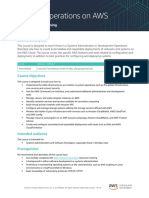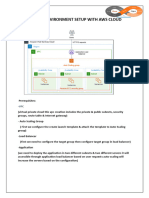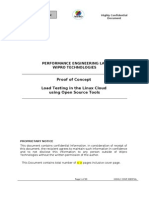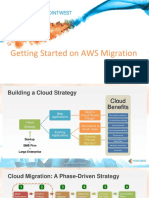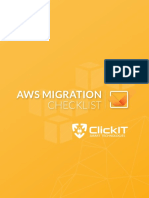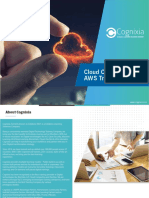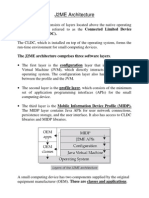Amazon Web Services
25/05/2016
Lucian Maly <lucian.maly@oracle.com
lucian.maly@oracle.com>
Proposal for
Small startup company (interview)
I. OBJECTIVE ............................................................................................................................... 3
II. PROBLEMS ................................................................................................................................ 3
III. GOALS ...................................................................................................................................... 3
IV. RECOMMENDATIONS ............................................................................................................ 3
V. TIMETABLE ................................................................................................................................ 5
VI. BUDGET .................................................................................................................................... 5
VII. NEXT STEP ................................................................................................................................. 6
VIII. CONCLUSION ......................................................................................................................... 6
APPENDIX A .......................................................................................................................................... 6
Lucian Maly <lucian.maly@oracle.com> Page 2 of 6
I. Objective
Dear customer of <<Small startup company>>, thank you for considering Amazon Web
Services as your future platform. This document contains our recommendations for
manageable, secure, scalable, high performing, efficient, elastic, highly available, fault
tolerant and recoverable cloud architecture that allows your organization to grow
organically.
II. Problems
Your current situation does not allow for un-quantified growth and is lacking prevention
of disaster. This is major risk for your operation and can potentially affect your business at
any time.
III. Goals
Analyze the <<Small startup company>> requirements and provide solutions using various
Amazon Web Services offerings, provide an architecture diagram and state all
assumptions made during the design and explicitly state how Amazon Web Services will
help overcome the current problems specific to the company. Reader is expected to
have basic computer knowledge, but not necessarily Amazon Web Services exposure.
IV. Recommendations
When architecting for the cloud, one must assume that anything can fail at any time. In
order to prevent that from happening, it is necessary to break down its components into
smaller, decoupled pieces and work with each of them separately, that is – separate
computing, storage, and database and apply principles to each.
Amazon Web Services brings lot of built-in features to address business continuity. I
recommend using Elastic Load Balancing (ELB) and multiple Availability Zones (essentially
separate data centers in the same region) for all of your servers. Not only that, it will
effectively distribute load among your Elastic Compute Cloud (EC2) Linux servers, but
also ensures that your services will be unaffected if one data center becomes
unavailable for some reason.
We provide three different types of EC2 instances – on demand, reserved (for a specific
period of time) and spot instances (bid on unused instances) and allow for flexibility in
choice of size also. I recommend starting with smaller on-demand instances and once
you understand the level of workload, choose the right size and combine on demand
and reserved instances. The options are endless.
Lucian Maly <lucian.maly@oracle.com> Page 3 of 6
In certain scenarios, such as when flash traffic is expected, or in the case where a load
test cannot be configured to gradually increase traffic, we recommend that you
contact us to have your load balancer "pre-warmed". We also recommend using only
secure protocols listeners and enabling SSL termination on the ELB to release load on the
backend instances.
Your company would particularly benefit from replicating the entire environment to
another AWS account using CloudFormation (using templates) or Cloudformer (snapshot
of the whole infrastructure). This will give you the ability to leverage two exactly the same
environments – either for testing purposes or in combination with the highly available DNS
service Route 53 and Machine Images (AMI) (snapshot of your server) in different regions
in a stand-by or multi-site scenario.
Just make sure you tag (key/value pair to easily identify resources) your instances from
day one – it will makes things easier later on when you have many more resources to
manage. Both AWS accounts can be linked using consolidated billing which gives you
the ability to see it all in one place.
Security of data in transit is taken with the utmost priority. All of the virtual servers are
completely isolated by design, and on the top of that, one of the most important
networking features we provide is resource isolation using Virtual Private Cloud (VPC).
Security group acts as a virtual firewall for your instances in to control inbound and
outbound VPC traffic and Network Access Lists (NACL) is another, optional layer of
security for your VPC that controls traffic between one or more subnets.
Scaling to meet the demand with uncertainty around when and how much this demand
will be, is extremely easy with Amazon Web Services. Our EC2s come with elasticity out of
the box. When configured to do so, Scaling Groups (template of EC2 instances) and
Auto Scaling (rules for scaling) will automatically increase the amount of instances when
the load is high (or at a specific time) and decreases the amount, when the load is low.
You don’t have to buy too much infrastructure too soon or not enough too late, it is all
happening automatically.
I also highly recommend specifying user data while creating EC2 instances to run a
configuration script during launch. This is a simple auto-healing/bootstrapping option that
can for example fetch the default configuration from highly durable storage Simple
Storage Service (S3) (online file storage) and will ensure failed/unhealthy instances are
always replaced and restarted with the default configuration. Server side encryption is
possible with S3, so you can be absolutely confident that your data is secure.
Later on, I definitely suggest registering existing instances to OpsWorks and automate
operations in your stack. This gives you an even better self-healing infrastructure option
that recovers from failed service instances using the native auto healing feature of
OpsWorks.
It would be a great benefit for your company <<Small startup company>> if objects with
infrequent access in S3 (with either standard or reduced redundancy type of storage) will
be automatically archived by lifecycle management rules to Glacier. That is our leading
lower cost archiving product with 3-5 hours retrieval policy.
Lucian Maly <lucian.maly@oracle.com> Page 4 of 6
The ability to configure your database and data access layer for high performance and
throughput is a matter of a few clicks in the AWS console. Our managed Relational
Database Service (RDS) provides MySQL engine and is fully scalable and has multi AZ
failover using synchronous physical replication and automatic backups by default. If that
is not enough, you can also very easily create read replica(s) for heavy database
workloads or improve performance with ElastiCache (in memory caching using
MemcacheD or Redis engines).
If a large portion of your user base is long distance, we can significantly help you improve
latency and user experience in their browsers using CloudFront (content delivery
network). This allows distributing objects from S3 to the edge locations/endpoints closer
to your customers and they will always have a better chance of retrieving the file(s) from
closer to them.
We take security very seriously here at Amazon Web Services and provide many different
levels of protection. The first layer of security is Identity & Access Management (IAM)
which enables you to manage users and user permissions and secures access to the
environment. The rule of thumb is to grant minimum possible access that is necessary.
Each user can have certain policies attached to his/her account, allowing him to use
specific AWS resources. I recommend using user groups (at least three: administrators,
power users and read-only) for easier user management especially if you expect team
expansion. Always make sure you enable multi-factor authentication (MFA) on all of your
accounts which adds another layer of protection. We also support SAML protocol which
simplifies authentication and user migration if you already have users on your directory
server.
V. Timetable
I recommend breaking the project into phases, and have a schedule for each phase.
Times will vary based on the size of the current setup, but for standard architecture of this
type, you should expect that:
Table 1
Phase Description of Work Duration
Phase One Create resources in AWS Immediately
Migrate your on-premise to AWS, both
Phase Two ~1 month
systems will run in parallel, perform tests
Phase Three Shut down on premise and only use AWS ~1 day
VI. Budget
One of the major benefits of our platform is that you only pay for what you use (pay-as-
you-go model). It is fair to say that at the early stages, most of the cost will come from
compute and storage. Throughout the time, it will become clearer what the cost is
during busy and idle periods. To give you some idea, I included two of the most typical
similar scenarios and corresponding costs:
Lucian Maly <lucian.maly@oracle.com> Page 5 of 6
Table 2
Type Region URL Anticipated Costs
Simple https://calculator.s3.amazonaws.com/index.htm
~$230 (USD per
marketing Sydney l#key=calc-19ED1A76-86E5-4E5B-BCFA-
month per region)
site 009D565A125A&r=SYD
Large on- https://calculator.s3.amazonaws.com/index.htm
~$1280 (USD per
demand Sydney l#key=calc-1B74B8A3-430B-42D9-A294-
month per region)
web site 9B0CD82395E7&r=SYD
VII. Next step
Our solutions team is here for you 24/7 to discuss and evaluate progress throughout and
at the end of the project. Our website http://aws.amazon.com/ is also great source of
information and please keep in mind that we have four different types of extremely
helpful post-sales technical support.
VIII. Conclusion
We focus on the key inputs for your business and deliver them with the right quality and in
a timely fashion. The above solution provides zero upfront investment, efficient resource
utilization, and usage-based costing and zero-day time to market. Do not hesitate to
contact me anytime, should you have any further questions. On the behalf of Amazon
Web Services I wish you a great success and I sincerely hope we will be your choice and
companion in your cloud journey.
Appendix A
Attached is the schema of the proposed solution.
Legend:
• ELB = elastic load balancer
• EC2 = elastic compute cloud
• AZ1, AZ2 = different availability zones
• Low opacity icons (Glacier, ElastiCache, OpsWorks) = highly recommended, but
not required
Lucian Maly <lucian.maly@oracle.com> Page 6 of 6

















